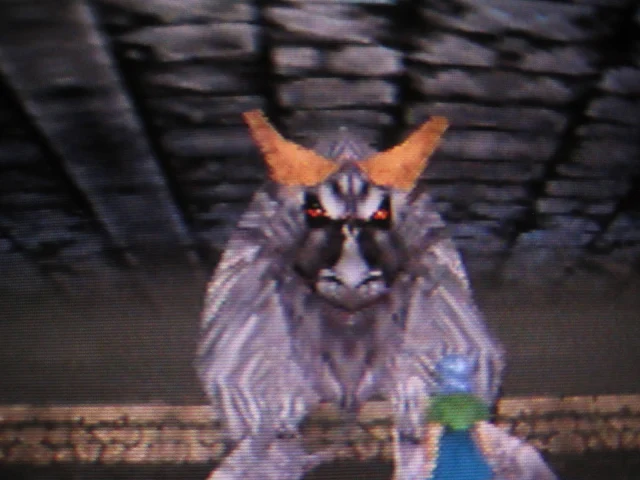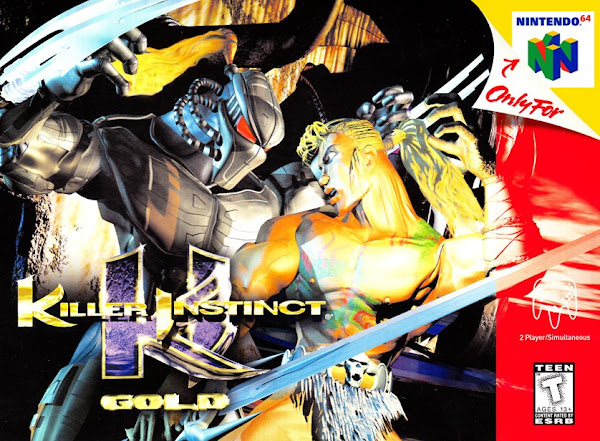Castlevania

Released on January 26, 2001 by Konami Computer Entertainment Kobe, Castlevania takes the classic, platform-jumping, vampire-whipping action of its 2D-Castlevania predecessors into the third-dimension, as two distinct protagonists fight to prevent yet another attempt at world domination by Count Dracula.
The Personal Story: I've one abiding memory of the original Castlevania trilogy for the NES: those games were very, very difficult. I made little progress through my friends' copies. By the time the SNES rolled around, I was a more skilled gamer, and I was able to get quite far through Castlevania IV, though I didn't beat it until college. When the Nintendo 64 trotted out its 3D take on Castlevania, I was too wrapped up in Zelda, Banjo, and EA's Beetle Adventure Racing to give it a shot. Most egregiously, I even gave time to the hated Playstation's Castlevania: Symphony of the Night, one of the greatest games of all time, beating it twice. Castlevania, or "Castlevania 64," as gamers branded it, actually received decent reviews upon its release, with the caveat that it was not as good as the closely released Symphony of the Night. "Castlevania 64" only achieved a negative reputation years later, due to the rampant meme culture of the early '10's, which valued cheap, easy laughs over actual facts and evidence. Those very memes clashed so harshly with my memories of the game's initial reviews that I finally decided to play through the game, and at last form a Castlevania opinion of my own.

How did a shot from my snuff film get in here?!
Graphics: Castlevania is one of the most graphically uneven Nintendo 64 games. Textures are often blurry, fuzzy, and muddy, resulting in some walls, floors, and objects that are not so easy on the eyes. For a major studio game released halfway through the Nintendo 64's life-cycle (taking the perspective that the Nintendo 64 is not, in fact, immortal), this is unforgivable. On the other hand, character-animation is superb and life-like, from the crack of the player's whip, to the terrifyingly swift movement of one of the game's creepy "crawler" vampires, to the lumbering gait of Castlevania's enormous bosses. Castlevania's architecture and environments are well and sometimes stunningly designed, though they are at times blanketed by the aforementioned fuzzy textures. Real-time lighting is simplistic, but it's there, from lightning strike illumination, to the shine of a torch on clothing, to a red-tinted lava pit. Graphical slowdown does at times occur, particularly in levels featuring a large amount of moving objects (The Tower of Execution, for example), and sometimes inexplicably. The game also makes use of distance fog, not at the rate of say, Turok: Dinosaur Hunter, and sometimes for atmospheric effect, but still, it's there, as well. Castlevania's graphics essentially include every issue from the laundry list of common Nintendo 64 graphical complaints, but the game also contains enough eye-pleasing moments to offset them. Overall, as far as Nintendo 64 graphics go, Castlevania runs slightly ahead of the middle of the pack.

Pictured: Garth Brooks
Sound: Castlevania tricks players into thinking they've got their hands on a fully voice-acted game. The opening introduction is well-read by a narrator, the protagonist speaks, and then there isn't any voice-acting for the rest of the game--all of the remaining dialogue is text-based. However, Castlevania's sound effects are vast and top notch, from thunder, wind, and rain, to the crack of weapons, to boots on stairs, to the satisfying, echoed death-screams of disintegrating vampires. Music is well done, with Castlevania implementing ambient sound at select moments for atmosphere, but mostly relying on a fitting, if unmemorable score throughout. Every level has its own distinct musical theme, but Castlevania's aural highlight comes during the game's opening menu, featuring a real, mournful violin, which leads into a gorgeous, moving orchestral piece. In a lovely touch, perhaps inspired by the Nintendo 64's recently released, but tonally opposite, Banjo Kazooie, the menu is animated to have a main character performing this music (in this case, the mysterious Malus). While the rest of Castlevania's soundtrack is solid, it never again comes close to the heights of this opening piece.

Superimpose me over the moon/drive a stake through my heart, baby go my favorite song lyrics I just made up
Gameplay: From the menu, the player can select either "Easy" or "Difficult" mode, and has a choice of beginning the game with either young witch, Carrie Fernandez, or heir to the vampire-slaying Belmont clan, Reinhardt Schneider. There is no option to switch characters once the journey to the top of Dracula's castle has begun.
The chief difference in the two characters lies in their method of attack. The diminutive Carrie casts spheres of energy akin to heat-seeking missiles. She is an asset when fighting slow moving foes, as the player can simply run away or around the enemy, cast Carrie's spells, and watch them seek enemies, then explode on contact. However, against swift-moving foes, Carrie's energy balls become a liability, unable to hit enemies unless they are cast from an extremely short distance. Schneider, on the other hand, uses the classic Castlevania bullwhip (though unfortunately, it isn't as elastic as Castlevania IV's series-standout whip). This allows Schneider to be quite deadly at close range, though he has to jump and swing to hit taller or floating enemies.
Carrie's spell and Reinhardt's whip can be powered up twice per level (with found pick-ups), but lose your life, or save and turn the game off, and the power-ups are lost. Both characters have a short-range weapon, Carrie bladed rings, Schneider a dagger, both similar in function and power. The duo also have access to the four classic Castlevania projectile weapons: the cheap but weak throwing knife, the stationary holy water, the high-powered, but costly throwing cross, and the well-balanced throwing axe. Only one of these four weapons may be stocked at any specific time. Cost is mentioned because each projectile weapon toss uses a certain amount of red jewels, which are collected throughout the game.
Monster-fighting combat is fun, with each attack button well-mapped on the Nintendo 64 controller. The game's wily camera can be an issue, though this is partially remedied by a rudimentary enemy targeting system, accessed by the shoulder button. While this enemy lock-on mechanic isn't as advanced as the one found in The Legend of Zelda: Ocarina of Time, which was released on the Nintendo 64 two months before Castlevania (and where it was not only originated, but perfected), it is appreciated.
There's far more to Castlevania than combat, though, which brings up Castlevania's greatest asset: unpredictability.
 For instance, who would've predicted this Giant Skeleton boss would turn purple when I hit him? Maybe he has a calcium deficiency?
For instance, who would've predicted this Giant Skeleton boss would turn purple when I hit him? Maybe he has a calcium deficiency?Castlevania's opening level pits the player against a boss within the first three minutes, provides a lot of open space to battle limitless enemies, and features just a bit of platform-jumping. The second level features far more platforming, which is both exhilarating and frustrating. Much of the frustration comes from the game's stubborn camera. Often, the player can finagle the camera into an agreeable position before jumps, but the process, generally consisting of toggling around with the targeting shoulder button and one of the yellow "c-buttons," can be quite tedious. The controls are also a bit finicky when it comes to jumping, as well. The player will fall to their death many times early on, before getting used to the unintuitive way Castlevania wishes for them to handle things--the camera and controls for the platform sections simply should have been fine-tuned better.
However, once the player adjusts to these nagging issues, there's a lot of old-school platforming challenge to be enjoyed--this is, after all, a Castlevania game.
Castlevania's third stage is one of its most varied, as the player finds themselves in a Villa inside the castle grounds. At this point, the game introduces several non-playable characters, who deepen Castlevania's story, add emotional stakes, and give the game a bit more of a fully-realized world. This stage also contains Castlevania's standout moment, as the player is stalked through a hedge maze by a chainsaw-welding Frankenstein's monster and his two enormous hounds of hell.This terrifying segment adds a psychological, survival horror element to the game, as these enemies can be momentarily disabled, but never killed. The chase continues until the player either escapes or dies.
Over the next seven stages, Castlevania is similarly unpredictable, bouncing between pure action or platforming stages, combinations of the two, boss fights at seemingly any moment, and simplistic puzzles, These puzzles are few, and are often confined to figuring out a password through clues found throughout a stage. The game's ten levels may also suddenly feature an on-rails segment, a "carry a bomb and if you get hit or jump you die" segment, or a surprise cage-match in a booby-trapped room segment, among others. Taking into account all this variation, though, Castlevania's game-play experience is surprisingly short.

She must have read too many of my reviews.
Lasting Value: Castlevania does not include any sort of multi-player mode. Its ten stages can be bested by an experienced gamer in five or six hours, though the average player may take up to ten. After that, one has the opportunity to play through the game with the second character. The two characters' paths are similar, but each can access three stages and one boss the other cannot. The distinct differences in Carrie's and Reinardt's attack styles, as well as these six different levels, which are among the game's best, make playing through Castlevania with each character essential. However, doing this still only results in about 15 hours playing time, maximum. Castlevania does offer those who take down its "normal" difficulty mode a "hard mode," but this setting is only for the die-hard fan, as most players will have found the 15 hours of frustrating fun they spent in this 64-bit, 3-dimensional Transylvania enough.
7.5
Graphics
Contains plenty of blurry, ugly textures, but environments look okay, overall. Character animation is stellar. Slowdown abounds, but doesn't break the game.
8.0
Music and Sound
Good early voice-work, but disappears completely past the game's five-minute mark. Excellent sound-effects, and a solid, workmanlike score.
7.8
Gameplay
Surprisingly varied, with a good balance of challenging platforming, fun supernatural combat, and survival horror, though the camera-system often gets in the way.
6.5
Lasting Value
No multi-player, and the single-player adventure, despite two different character paths, doesn't last terribly long, though Castlevania does feel like it ends when it should.
7.5 FINAL SCORE



Comments
Post a Comment